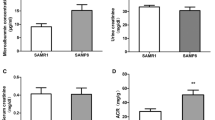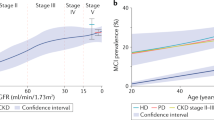Abstract
The purpose of this study was to determine changes in klotho, endothelin (ET) receptors, and superoxide production in kidneys of aged rats and whether these changes are exacerbated in aged rats with cognitive impairment. Twenty aged rats (male, 27 months) were divided into an Old Impaired group (n = 9) and an Old Intact group (n = 11) according to a cognitive function test. A group of 12-month-old rats (n = 10) was used as a Young Intact group. Serum creatinine was increased significantly in the Old Impaired group, suggesting impaired renal function. Aged rats showed glomerulosclerosis and tubulointerstitialfibrosis. These pathological changes were markedly aggravated in the old cognitively impaired than in the old cognitively intact animals. Notably, aged rats demonstrated a significant decrease in klotho protein expression in renal cortex and medulla. Protein expression of IL-6, Nox2, ETa receptors and superoxide production were increased whereas mitochondrial SOD (MnSOD) and ETb receptors expression were decreased in kidneys of the aged rats. Interestingly, these changes were more pronounced in the old impaired than in the old intact rats. In conclusion, the aging-related kidney damage was exacerbated in aged rats with cognitive impairment. Klotho, ETB, and MnSOD were downregulated but ETa, IL-6, Nox2, and superoxide production were upregulated in the aging-related kidney damage. These changes were more pronounced in rats with cognitive impairment.








Similar content being viewed by others
References
Abassi ZA, Ellahham S, Winaver J, Hoffman A (2001) The intrarenal endothelin system and hypertension. News Physiol Sci 16:152–156
Afiatpour P, Latifpour J, Takahashi W, Yono M, Foster HE Jr, Ikeda K, Pouresmail M, Weiss RM (2003) Developmental changes in the functional, biochemical and molecular properties of rat bladder endothelin receptors. Naunyn Schmiedebergs Arch Pharmakol 367:462–472
Aizawa H, Saito Y, Nakamura T, Inoue M, Imanari T, Ohyama Y, Matsumura Y, Masuda H, Oba S, Mise N, Kimura K, Hasegawa A, Kurabayashi M, Kuro-o M, Nabeshima Y, Nagai R (1998) Downregulation of the Klotho gene in the kidney under sustained circulatory stress in rats. Biochem Biophys Res Commun 249:865–871
Bello Roufai M, Li H, Sun Z (2007) Heart-specific inhibition of protooncogene c-myc attenuates cold-induced cardiac hypertrophy. Gene Ther 14:1406–1416
Chen GF, Sun Z (2006) Effects of chronic cold exposure on the endothelin system. J Appl Physiol 100:1719–1726
Crosswhite P, Sun Z (2010) Ribonucleic acid interference knockdown of interleukin 6 attenuates cold-induced hypertension. Hypertension 55:1484–1491
Czarkowska-Paczek B, Bartlomiejczyk I, Gabrys T, Przybylski J, Nowak M, Paczek L (2005) Lack of relationship between interleukin-6 and CRP levels in healthy male athletes. Immunol Lett 99:136–140
Dammanahalli JK, Sun Z (2008a) Endothelin (ET)-1 inhibits nicotinamide adenine dinucleotide phosphate oxidase activity in human abdominal aortic endothelial cells: a novel function of ETB1 receptors. Endocrinology 149:4979–4987
Dammanahalli KJ, Sun Z (2008b) Endothelins and NADPH oxidases in the cardiovascular system. Clin Exp Pharmacol Physiol 35:2–6
Del Ry S, Maltinti M, Giannessi D, Cavallini G, Bergamini E (2008) Age-related changes in endothelin-1 receptor subtypes in rat heart. Exp Aging Res 34:251–266
Ej M (1995) Aging. In: Ej M (ed) Handbook of physiology. Oxford University Press, New York, pp 3–24
Franchini A, Ottaviani E (2007) IL-6 immunoreactivity changes during aging in the polychaete Ophryotrocha labronica (Polychaeta: Dorvilleidae). Tissue Cell 39:27–34
Freeman WM, Vanguilder HD, Bennett C, Sonntag WE (2009) Cognitive performance and age-related changes in the hippocampal proteome. Neuroscience 159:183–195
Friedman EM, Hayney M, Love GD, Singer BH, Ryff CD (2007) Plasma interleukin-6 and soluble IL-6 receptors are associated with psychological well-being in aging women. Health Psychol 26:305–313
Haruna Y, Kashihara N, Satoh M, Tomita N, Namikoshi T, Sasaki T, Fujimori T, Xie P, Kanwar YS (2007) Amelioration of progressive renal injury by genetic manipulation of Klotho gene. Proc Natl Acad Sci USA 104:2331–2336
Houben JM, Moonen HJ, van Schooten FJ, Hageman GJ (2008) Telomere length assessment: biomarker of chronic oxidative stress? Free Radic Biol Med 44:235–246
Izad M, Vodjgani M, Niknam MH, Amirzargar A, Shahbeigi S, Heidari AB, Keramatipour M (2010) Cytokines genes polymorphisms and risk of multiple sclerosis. Am J Med Sci 339:327–331
Jung T, Bader N, Grune T (2007) Lipofuscin: formation, distribution, and metabolic consequences. Ann NY Acad Sci 1119:97–111
Koh N, Fujimori T, Nishiguchi S, Tamori A, Shiomi S, Nakatani T, Sugimura K, Kishimoto T, Kinoshita S, Kuroki T, Nabeshima Y (2001) Severely reduced production of klotho in human chronic renal failure kidney. Biochem Biophys Res Commun 280:1015–1020
Krause KH (2007) Aging: a revisited theory based on free radicals generated by NOX family NADPH oxidases. Exp Gerontol 42:256–262
Kuiper JW, Versteilen AM, Niessen HW, Vaschetto RR, Sipkema P, Heijnen CJ, Groeneveld AB, Plotz FB (2008) Production of endothelin-1 and reduced blood flow in the rat kidney during lung-injurious mechanical ventilation. Anesth Analg 107:1276–1283
Kuro-o M (2008) Klotho as a regulator of oxidative stress and senescence. Biol Chem 389:233–241
Kuro-o M, Matsumura Y, Aizawa H, Kawaguchi H, Suga T, Utsugi T, Ohyama Y, Kurabayashi M, Kaname T, Kume E, Iwasaki H, Iida A, Shiraki-Iida T, Nishikawa S, Nagai R, Nabeshima YI (1997) Mutation of the mouse klotho gene leads to a syndrome resembling ageing. Nature 390:45–51
Kurosu H, Yamamoto M, Clark JD, Pastor JV, Nandi A, Gurnani P, McGuinness OP, Chikuda H, Yamaguchi M, Kawaguchi H, Shimomura I, Takayama Y, Herz J, Kahn CR, Rosenblatt KP, Kuro-o M (2005) Suppression of aging in mice by the hormone Klotho. Science 309:1829–1833
Lattmann T, Shaw S, Munter K, Vetter W, Barton M (2005) Anatomically distinct activation of endothelin-3 and the l-arginine/nitric oxide pathway in the kidney with advanced aging. Biochem Biophys Res Commun 327:234–241
Mendoza-Nunez VM, Ruiz-Ramos M, Sanchez-Rodriguez MA, Retana-Ugalde R, Munoz-Sanchez JL (2007) Aging-related oxidative stress in healthy humans. Tohoku J Exp Med 213:261–268
Mitani H, Ishizaka N, Aizawa T, Ohno M, Usui S, Suzuki T, Amaki T, Mori I, Nakamura Y, Sato M, Nangaku M, Hirata Y, Nagai R (2002) In vivo klotho gene transfer ameliorates angiotensin II-induced renal damage. Hypertension 39:838–843
Mitobe M, Yoshida T, Sugiura H, Shirota S, Tsuchiya K, Nihei H (2005) Oxidative stress decreases klotho expression in a mouse kidney cell line. Nephron Exp Nephrol 101:e67–e74
Morris RG, Garrud P, Rawlins JN, O’Keefe J (1982) Place navigation impaired in rats with hippocampal lesions. Nature 297:681–683
Munusamy S, MacMillan-Crow LA (2009) Mitochondrial superoxide plays a crucial role in the development of mitochondrial dysfunction during high glucose exposure in rat renal proximal tubular cells. Free Radic Biol Med 46:1149–1157
Nagai T, Yamada K, Kim HC, Kim YS, Noda Y, Imura A, Nabeshima Y, Nabeshima T (2003) Cognition impairment in the genetic model of aging klotho gene mutant mice: a role of oxidative stress. FASEB J 17:50–52
Raij L, Chiou XC, Owens R, Wrigley B (1985) Therapeutic implications of hypertension-induced glomerular injury. Comparison of enalapril and a combination of hydralazine, reserpine, and hydrochlorothiazide in an experimental model. Am J Med 79:37–41
Seccia TM, Maniero C, Belloni AS, Guidolin D, Pothen P, Pessina AC, Rossi GP (2008) Role of angiotensin II, endothelin-1 and L-type calcium channel in the development of glomerular, tubulointerstitial and perivascular fibrosis. J Hypertens 26:2022–2029
Soleman S, Yip P, Leasure JL, Moon L (2010) Sustained sensorimotor impairments after endothelin-1 induced focal cerebral ischemia (stroke) in aged rats. Exp Neurol 222:13–24
Sugiura H, Yoshida T, Tsuchiya K, Mitobe M, Nishimura S, Shirota S, Akiba T, Nihei H (2005) Klotho reduces apoptosis in experimental ischaemic acute renal failure. Nephrol Dial Transplant 20:2636–2645
Sun Z (2010) Cardiovascular responses to cold exposure. Front Biosci (Elite Ed) 2:495–503
Sun Z, Bello-Roufai M, Wang X (2008) RNAi inhibition of mineralocorticoid receptors prevents the development of cold-induced hypertension. Am J Physiol Heart Circ Physiol 294:H1880–H1887
Suzuki D, Miyazaki M, Naka R, Koji T, Yagame M, Jinde K, Endoh M, Nomoto Y, Sakai H (1995) In situ hybridization of interleukin 6 in diabetic nephropathy. Diabetes 44:1233–1238
Suzuki T, Won KJ, Horiguchi K, Kinoshita K, Hori M, Torihashi S, Momotani E, Itoh K, Hirayama K, Ward SM, Sanders KM, Ozaki H (2004) Muscularis inflammation and the loss of interstitial cells of Cajal in the endothelin ETB receptor null rat. Am J Physiol Gastrointest Liver Physiol 287:G638–G646
Taguchi T, Nazneen A, Abid MR, Razzaque MS (2005) Cisplatin-associated nephrotoxicity and pathological events. Contrib Nephrol 148:107–121
Thomas SE, Anderson S, Gordon KL, Oyama TT, Shankland SJ, Johnson RJ (1998) Tubulointerstitial disease in aging: evidence for underlying peritubular capillary damage, a potential role for renal ischemia. J Am Soc Nephrol 9:231–242
Wang Y, Sun Z (2009a) Current understanding of klotho. Ageing Res Rev 8:43–51
Wang Y, Sun Z (2009b) Klotho gene delivery prevents the progression of spontaneous hypertension and renal damage. Hypertension 54:810–817
Wang X, Sun Z (2010) RNAi silencing of brain klotho potentiates cold-induced elevation of blood pressure via the endothelin pathway. Physiol Genomics 41:120–126
Wang X, Skelley L, Cade R, Sun Z (2006) AAV delivery of mineralocorticoid receptor shRNA prevents progression of cold-induced hypertension and attenuates renal damage. Gene Ther 13:1097–1103
Wang B, Dileepan T, Briscoe S, Hyland KA, Kang J, Khoruts A, Cleary PP (2010) Induction of TGF-beta1 and TGF-beta1-dependent predominant Th17 differentiation by group A streptococcal infection. Proc Natl Acad Sci USA 107:5937–5942
Yono M, Latifpour J, Takahashi W, Pouresmail M, Afiatpour P, Weiss RM (2004) Age-related changes in the properties of the endothelin receptor system at protein and mRNA levels in the rat vas deferens. J Recept Signal Transduct Res 24:53–66
Yukawa K, Kishino M, Goda M, Liang XM, Kimura A, Tanaka T, Bai T, Owada-Makabe K, Tsubota Y, Ueyama T, Ichinose M, Maeda M, Takeda K, Akira S (2005) STAT6 deficiency inhibits tubulointerstitial fibrosis in obstructive nephropathy. Int J Mol Med 15:225–230
Zhang R, Zheng F (2008) PPAR-gamma and aging: one link through klotho? Kidney Int 74:702–704
Zhang WW, Ma KC, Andersen O, Sourander P, Tollesson PO, Olsson Y (1994) The microvascular changes in cases of hereditary multi-infarct disease of the brain. Acta Neuropathol 87:317–324
Acknowledgements
This work was supported by the National Institute of Health (R01 HL077490) and the Reynolds Oklahoma Center on Aging.
Disclosures
Nothing to disclose.
Author information
Authors and Affiliations
Corresponding author
About this article
Cite this article
Zuo, Z., Lei, H., Wang, X. et al. Aging-related kidney damage is associated with a decrease in klotho expression and an increase in superoxide production. AGE 33, 261–274 (2011). https://doi.org/10.1007/s11357-010-9176-2
Received:
Accepted:
Published:
Issue Date:
DOI: https://doi.org/10.1007/s11357-010-9176-2




